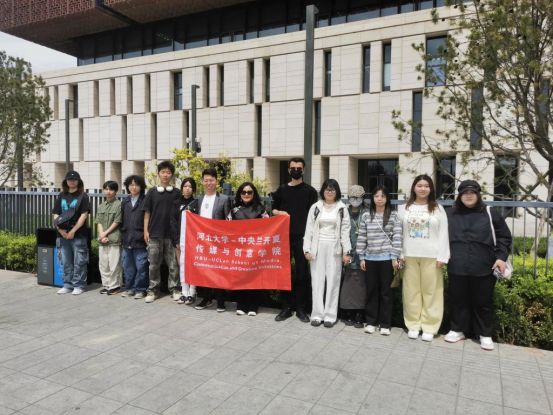On April 30, Lv Yi, Dean of the HBU-UCLan School of Media, Communication and Creative Industries, led a faculty and student delegation to conduct a research study at the China National Arts and Crafts Museum (China Intangible Cultural Heritage Museum) and the CAFA Art Museum. Through immersive investigations into intangible cultural heritage techniques and contemporary artistic creation, the participants deeply explored the dialogue between tradition and modernity, thereby infusing multidimensional perspectives into creative education.
At the morning, the delegation arrived at the China National Arts and Crafts Museum. The exhibition "The Dao of Life: Traditional Chinese Medicine Intangible Cultural Heritage" in Halls 1 and 2 on the first floor, structured around three core sections—"Cultural Continuity," "Wisdom of Life," and "Seasonal Wellness"—systematically presented nearly 50 intangible cultural heritage projects related to traditional medicine, including acupuncture and herbal processing. Through digital displays and live demonstrations by inheritors of these traditions, the group gained firsthand insight into the "living transmission" of Chinese medical culture.
On the fourth floor, Halls 3 to 6 featured "The Spirit of the Times: The 7th China Contemporary Crafts Biennale," while the fifth floor's Halls 7 to 10 hosted "Splendid Heritage: The Permanent Exhibition of Chinese Arts and Crafts." Additionally, on the sixth floor, Hall 12 presented "Radiant Attire: 2025 Dunhuang Costume Culture Research and Innovative Design Exhibition," and Halls 13 and 14 showcased "Vast and Varied: The Practice of Safeguarding China's Intangible Cultural Heritage." These exhibitions comprehensively demonstrated the fusion of traditional craftsmanship and modern design. Associate professor Bo Liwei remarked, "Intangible cultural heritage is not merely a vessel of techniques but also a crystallization of national wisdom. Contemporary creativity must extract cultural DNA from tradition and achieve transformation through innovation."
At the afternoon, the delegation proceeded to the CAFA Art Museum to visit the "2025 CAFA Graduation Season: Master's and Doctoral Degree Show." This exhibition themed "Toward the Light" (running from April 29 to May 14), featured graduation works by over 500 CAFA master's and doctoral candidates, spanning cutting-edge fields such as digital art, experimental video, and cross-media installations. Addressing global issues like technological ethics and ecological crises, the exhibition sparked lively discussions among the participants, particularly regarding AI-generated art and virtual reality interactive installations. Zhang Jiarui, an Interior design student, noted, "The interdisciplinary experimental nature of CAFA's graduation exhibition is profoundly inspiring. It reminds us that artistic creation must transcend disciplinary boundaries and engage with contemporary challenges through a more open vision."
This research trip represents a deepened implementation of the college's "outdoor Classroom" teaching model. Throughout the visit, teachers and students engaged in real-time documentation and group discussions, integrating exhibition analysis with curriculum design. Lecturer He Shuo explained, "We guide students to adopt a problem-oriented approach—for instance, exploring how to transform intangible cultural heritage patterns into digital IP or how to reconstruct traditional narratives using new media technologies. These topics will be further developed in subsequent studio projects."

